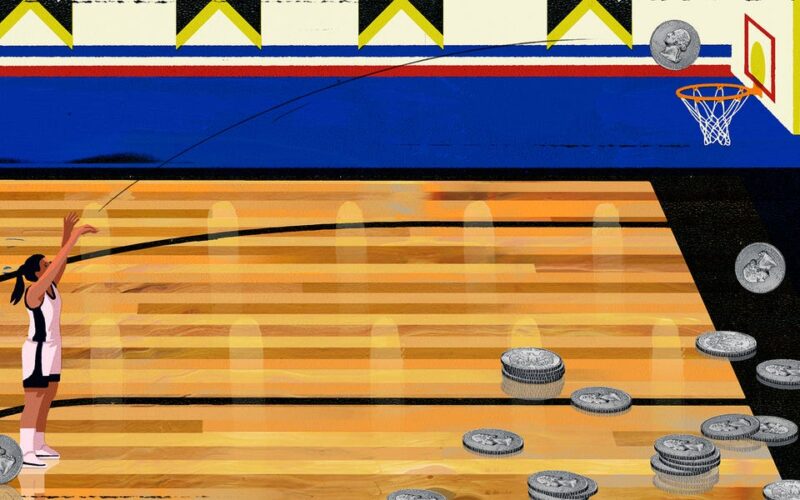- Athlete marketing has been shaken up since student-athletes gained the right to make money from their name, image, and likeness.
- NIL has created career paths for college athletes and brand-deal managers.
- This article is part of “Trends to Bet Your Career On,” a series about trending professional opportunities.
Before ever stepping foot on the court in the WNBA, the rookie and college-basketball phenom Caitlin Clark scored an eight-year shoe deal with Nike worth up to $28 million.
The deal, reported by The Wall Street Journal, is the richest sponsorship contract to date in women’s basketball. It came on the heels of other high-profile sponsorships for the leading NCAA Division I scorer, including with State Farm, which made her the first college athlete and female player to sign with the insurer.
Other athletes, like Clark, have leveraged their success in sports to strike brand deals and kick down doors once closed to amateurs.
Athlete marketing was upended in 2021 when the NCAA lifted its long-standing ban on student-athletes getting endorsement deals, which opened the door for them to make money from their name, image, and likeness.
College players — from the University of Southern California freshman basketball player Bronny James to the Louisiana State University gymnast Olivia Dunne — are earning millions a year from licensing and brand deals.
NIL has also created career paths for college athletes, some of whom are building businesses as influencers and content creators or getting jobs in social media and marketing rather than going pro. And it’s given rise to a cottage industry of companies helping student-athletes work with brands and managing logistics such as licensing and compliance.
According to the NIL marketplace Opendorse, spending on the NIL market hit an estimated $1 billion in its second year and is forecast to reach $1.17 billion in year three.
While the rules around NIL are still evolving, with recent developments setting the stage for schools to pay athletes directly and get involved with NIL deals, one thing is for sure: NIL isn’t going anywhere.
“Everyone needs to embrace it — I think schools, coaches, athletes, families. It is here to stay,” Garrett Yaralian, the head of NIL at WME Sports, told Business Insider. “It will continue to shift, and it’ll continue to kind of change.” It’s important for schools that want to be involved in NIL deals to engage in sports marketing and sourcing deals for athletes, he added.
Athletes are building careers as influencers
Dunne, who has 5.2 million followers on Instagram, where she’s been creating content since she was a teenager, is one of the top-earning student-athletes, with an annual NIL valuation of $3.9 million, according to On3.
Brands and talent agents are engaging with athletes like Dunne earlier in their careers, said Yaralian, who works with Dunne, TikTok, and the University of Texas at Austin track-and-field star Sam Hurley.
While Dunne and Hurley are still focused on competing, they may have other opportunities if they choose not to go pro after college, such as becoming full-time influencers, building consumer brands or products, or pursuing passions like fitness, Yaralian said.
Dunne already followed one of her passions last year by establishing the Livvy Fund to bring more NIL opportunities to her school’s female athletes.
Though Division I athletes seem to be among the highest earners, student-athletes of all levels are making money from NIL. Connor Printz, a former Division III basketball player at Claremont McKenna College, has landed over 100 NIL deals.
NIL has also helped some student-athletes set themselves up for careers outside athletics or content creation. The University of California, Los Angeles, quarterback Chase Griffin is working toward a master’s degree in legal studies because he wants to understand the contract side of talent and production work.
“This has just fast-tracked me for opportunities that I think I probably would’ve had with a lot of hustle at 27, 28, 29,” Griffin previously told BI. “Now I’m able to do it at 20, 21, and 22, all while still within the safety of my scholarship, the safety of education, and continuing to play the game I love.”
It’s not just student-athletes who are benefiting
NIL isn’t creating more career opportunities only for college athletes.
Sports marketing and talent agencies are staffing up to support their NIL work. WME Sports, for example, now has a dedicated team that sources NIL deals for student-athlete clients and a small team in Austin that supports the agency’s partnership with the Texas One Fund for University of Texas student-athletes.
A crop of companies has emerged around NIL, from platforms such as Opendorse, where brands and student-athletes can connect and access educational and compliance resources, to companies like The Brandr Group and OneTeam Partners that work on group licensing for jerseys, playing cards, and more.
Some of the donor-funded collectives that facilitate some 80% of NIL spending are also run like businesses with full-time staff.
There may be more opportunities on the horizon, too, if more schools bring NIL activities in-house as the University of Georgia Athletic Association has, with it hiring an athletic-marketing manager to lead the department.
Venture capitalists are also eyeing NIL startups as they see opportunities to provide financial resources to athletes, transform the fan experience, and offer tools to manage compliance.
“The future of the NIL will require technology to optimize and operationalize its structure to ensure a better financial future for athletes,” Drew Glover of Fiat Ventures wrote in March.
Source link
lol

